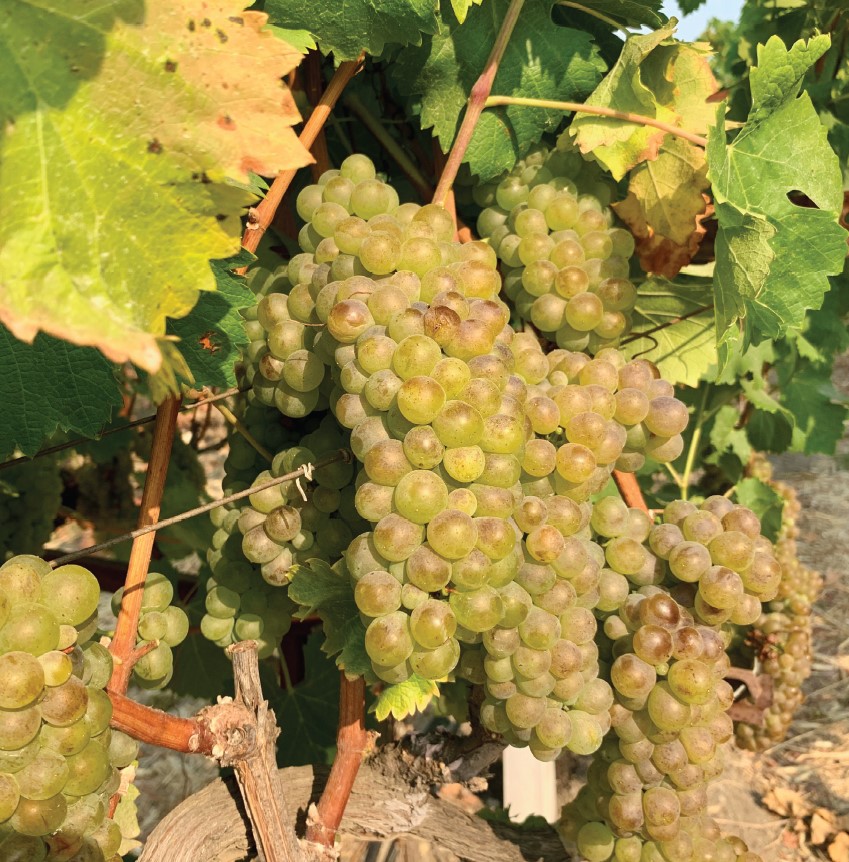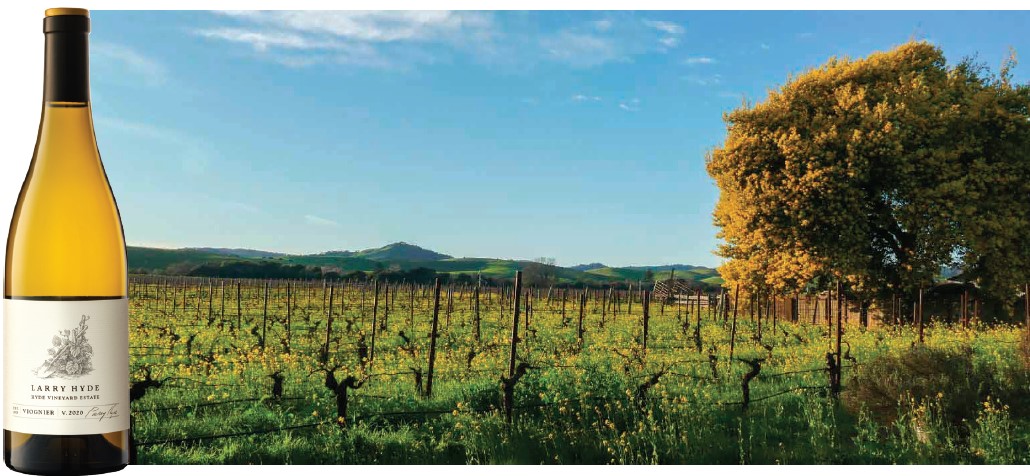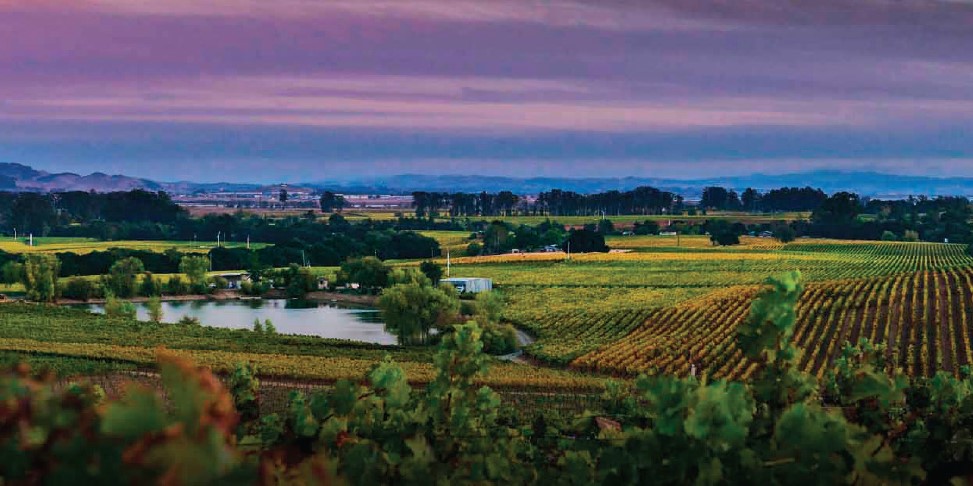Story By: Melissa Vogt // Viognier Grapes-Photo courtesy of Fortunati Vineyards
Select Producers Are Still Crafting Viognier in the Valley
In the Northern Rhône Valley of France, Viognier vines are rooted in small vineyard parcels in two tiny appellations: Condrieu and Chateau Grillet—the latter a namesake of a single producer. The location is flanked by the small Syrah-producing appellation of Côte Rôtie to the north and other well-known, Syrah-producing appellations of Saint Joseph, Hermitage, and Cornas stretching to the southern tip of the valley.
In its French expression, Viognier is characteristically a low-acid white wine with stone fruit flavors and a very distinct floral aroma. It’s a highly aromatic white with full body and offers significantly more texture than other white varietals. The low acidity gives it an unctuous composition and a distinct profile that really sets it apart from other French whites.
In California, there were roughly 3,000 planted acres of Viognier across the state in 2019, with much of the vines planted on the Central Coast.* Famed estate Tablas Creek Vineyard, a pioneer of Rhône varietals in California’s Central Coast appellation, likely stakes claim to the oldest planted Viognier in the state, dating to 1992.
In Napa Valley, the number of producers consistently crafting Viognier has dwindled in recent years, and production is so limited that estates sell out rapidly, creating a natural local scarcity. “There isn’t much of this varietal grown here or available to purchase from winegrowers,” said Ellen Reich-Luchtel, vintner and proprietor of Fortunati Vineyards. “In 2021, there was only 94 tons crushed in Napa Valley (versus 10,520 tons of Chardonnay crushed).” That being said, because the grape was nearly extinct worldwide as recently as the 1960s, those who are still crafting it locally have become the champions of this sophisticated French grape varietal.
Where Does Viognier Grow in Napa?
As with all Napa Valley wines, varietals come with their signature characteristics that harken to their origins while showcasing the terroir of the golden state. In France, Viognier does best when planted on granitic slopes with lots of sun exposure. In Napa Valley, Viognier is primarily grown in a handful of appellations: Los Carneros, Oak Knoll District, and Mt. Veeder—all cooler climate regions, given either their closeness to the San Pablo Bay or mountainous elevation. Across these appellations, sun exposure varies based on vineyard planting and slope level, and soil composition is distinct in each region. In the Oak Knoll District, the soils are predominantly sand, gravel, and clay. In the elevated appellation of Mt. Veeder, the soils are rockier and more influenced by ancient seabed deposits. In Los Carneros, they’re primarily rocky, shale-based clay.
In Los Carneros, at the southernmost point of Napa Valley, Hyde Vineyards Estate produces a very limited-production Viognier. This appellation is predominantly influenced by its proximity to San Pablo Bay. As a result, it is the coolest region in the Valley, and temperatures remain moderate even through the hottest times of the growing season, with morning and evening fog and a significant diurnal temperature shift. “The cool climate of our Los Carneros site allows for great acid retention,” stated Larry Hyde, Founder of Hyde Vineyards Estate and a trailblazer in the Los Carneros appellation long before it was officially designated an American Viticultural Area (AVA).
 For some, like Hyde, planting Viognier was merely just by chance. “I had come across this particular clone, and simply put, I had the opportunity to plant it and try it out. We were originally pleased with the results and continue to be impressed even more so as time goes by,” Hyde said. Los Carneros proved to be a good location for Viognier because “like in the Rhône Valley, our particular vineyard has a lot of rocks,” Hyde pointed out. In addition, Hyde’s Viognier vines possess an eastern exposition, “which means less heat from the afternoon sun,” he furthered. The Hyde Viognier has found a suitable home in this microclimate, and the resulting expression is delicate and balanced.
For some, like Hyde, planting Viognier was merely just by chance. “I had come across this particular clone, and simply put, I had the opportunity to plant it and try it out. We were originally pleased with the results and continue to be impressed even more so as time goes by,” Hyde said. Los Carneros proved to be a good location for Viognier because “like in the Rhône Valley, our particular vineyard has a lot of rocks,” Hyde pointed out. In addition, Hyde’s Viognier vines possess an eastern exposition, “which means less heat from the afternoon sun,” he furthered. The Hyde Viognier has found a suitable home in this microclimate, and the resulting expression is delicate and balanced.
In the Oak Knoll District at Fortunati Vineyards, Winemaker Gary and Proprietor Ellen Reich-Luchtel farm their vineyards sustainably. The estate’s commitment to Rhône-style wines is admirable. In addition to their single-varietal Viognier that they craft from estate vines at just 250 cases, they also make a Syrah co-fermented with 5% of that Viognier—produced in the traditional French way that gives Rhône Syrah such a lovely fragrance.
At Darioush, their Viognier also comes from estate-grown vineyards in the Oak Knoll District. “Our estate in the Oak Knoll AVA benefits from the dense early morning fog and late afternoon breezes – ideal attributes to help Viognier ripen slowly and completely,” said Alessandra Murillo, Director of Marketing at Darioush. As producers who love to champion unexpected grape varietals, “Viognier has garnered its place as one of Darioush’s most beloved offerings,” Murillo furthered.
While local bottlings of Viognier vary in style, they all possess those quintessential floral aromas that make Viognier so easily detectable in a blind tasting. Napa Valley producers who craft this limited varietal do so not because it’s profitable or prolific but because they love the grape and want to showcase its beauty as an alternative to more common Napa Valley whites like Chardonnay. Production is extremely limited, and many estates sell out of their bottlings quickly, so garnering these wines can be a challenge. It is recommended to reach out to the estates to check availability before visiting to purchase.
* Source: www.coravin.com





